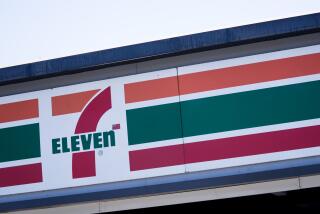First Wave of Storm Drenches Southland
- Share via
The Pacific Ocean storm that lashed Southern California with rain and snow Friday was expected to intensify tonight and Sunday, posing an increasing threat of floods and mudslides.
High-surf advisories, flash-flood watches and warnings of major mudslides were issued for the hillsides and coastal areas of Los Angeles, Ventura and Santa Barbara counties, along with winter storm warnings for the mountains.
“This storm is large, it’s full of moisture and there’s more on the way,” said William Patzert, a meteorologist at the Jet Propulsion Laboratory in Pasadena.
“Saturday night and Sunday will be a soaker, and it will keep on raining on Monday,” he said. “We’re going to have mudslides and flooding. Home Depot will do a landslide business in tarpaulins.”
The National Weather Service said Friday that the storm was arriving in three waves.
The first rumbled in before dawn Friday, accompanied by thunder, lightning and winds of up to 75 mph.
Snow near Gorman blocked Interstate 5, the state’s main north-south highway, for several hours, and several roads were closed by snow in the San Gabriel Mountains. The snowfall was widespread, whitening the ground in Palmdale and Las Vegas and piling up several feet in parts of the High Sierra.
Up to 3 1/2 inches of rain fell in the mountains of Santa Barbara County, with about half that much on the hillsides and lowlands of Ventura and Los Angeles counties. Several small mudslides were reported, and a tree toppled onto a dormitory at Osaka University in Studio City. There were no reports of injuries.
The California Highway Patrol said rain-slick pavement apparently was a factor in a traffic accident that killed a man in Camarillo on Friday afternoon. Officers said the man’s sport utility vehicle skidded off a road and toppled into an irrigation ditch, where he apparently drowned. The man was not identified.
Officials reported power outages at about 30,000 residences and businesses in Los Angeles and Orange counties, but in most cases, electrical service was restored before nightfall. Rain seeping into rooms at the Southwest Museum in the Mount Washington area prompted officials to close the facility through Jan. 23.
Several major thoroughfares in Orange County were closed temporarily by flooding, including Pacific Coast Highway in Huntington Beach, the Riverside Freeway near Orange and the Garden Grove Freeway in Santa Ana.
In Laguna Beach, where mudslides killed a homeowner in 1998, volunteers passed out fliers warning everyone to be careful.
“We’re just trying to give residents a heads up,” said Laguna Beach Police Capt. Paul Workman. “If it comes down in buckets, it’ll cause problems.”
In Ventura County, the rising waters of the Santa Clara River invaded a mobile home park. At a church in Santa Clarita on Friday night, dozens of people were temporarily stranded by water. Farther downstream, officials ordered the evacuation of an equestrian center near the fast-rising Santa Clara River near Fillmore.
The second and most powerful wave of the storm was expected tonight and Sunday.
“Rainfall rates during the peak periods may exceed 1 inch an hour,” the National Weather Service said in an advisory. “Rainfall totals for the weekend should range from 3 to 6 inches for the coastal and valley areas to 5 to 10 inches in the foothills and mountains, with local totals of up to 15 inches on some south-facing slopes.”
JPL meteorologist Patzert was a bit more conservative, saying that although he expected heavy rains, he doubted the totals would be that high.
Forecasters said previous heavy rains thoroughly saturated the ground and that the potential for flooding was high. The storm had dumped 1.73 inches of rain on downtown Los Angeles by 4 p.m. Friday, raising the total for the season, which began July 1, to 14.41 inches. That’s almost four times the normal total for the date.
Street and roadway flooding was likely in flood-prone areas, and rivers were expected to rise significantly.
Police warned motorists to avoid the Sepulveda Boulevard tunnel under the south runways at Los Angeles International Airport. The tunnel often floods during rainstorms.
Forecasters said the mudslide threat would be greatest below slopes that burned in wildfires during the last two summers, especially in Ventura, Los Angeles and San Bernardino counties.
Residents of Devore and Lytle Creek, two San Bernardino County communities devastated by floods that followed wildfires in 2003, watched anxiously Friday as the rain continued to fall.
“I used to love the rain,” said Dallas Branscone of Devore. “Now, I dread all these storms.”
Along Greenwood Avenue, a deeply rutted, flood-prone road in Devore, Thom Master was building a barrier of sandbags.
“You can only do so much,” he said. “If 2 feet of mud comes, these little sandbags aren’t going to do much.”
San Bernardino National Forest Ranger Gabriel Garcia, who works in Lytle Creek, said he had been getting calls all day from worried residents.
“Before the fires, none of us slept well, because we knew what was going to happen,” he said. “We’re still not sleeping well.”
The third wave of the storm was expected Monday. Forecasters said it probably wouldn’t be as powerful as the first two, but because it was expected to be warmer, it would pose its own problems. Snow levels were expected to rise markedly, to above 7,000 feet, and the rain below that was expected to melt a lot of the snow deposited earlier, increasing the storm runoff.
*
Times staff writers Mai Tran and Sara Lin in Orange County and Fred Alvarez and Daryl Kelley in Ventura County contributed to this report.
More to Read
Sign up for Essential California
The most important California stories and recommendations in your inbox every morning.
You may occasionally receive promotional content from the Los Angeles Times.














